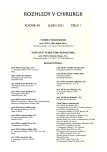Ischemic Colitis Following AAA Procedures
Authors:
R. Necpal; V. Šefránek; R. Slyško; J. Tomka
Authors‘ workplace:
Klinika cievnej chirurgie, Národný ústav srdcových a cievnych chorôb v Bratislave, Slovenská republika, prednosta kliniky: prof. MUDr. Vladimír Šefránek, Ph. D.
Published in:
Rozhl. Chir., 2011, roč. 90, č. 1, s. 31-36.
Category:
Monothematic special - Original
Overview
Introduction:
Bowel ischemia following the AAA operation is a rare complication. However, it is the most common reason of death after elective AAA operation with the incidence of 5–9% and 30–60% following RAAA operation with mortality rate around 60%.
Methods:
Retrospective analysis of 207 patients undergoing elective and emergent AAA operation between 1st January 2007 and 31st July 2010 was made. We evaluated clinical and para clinical symptoms leading to the observed diagnosis.
Results:
During the observed period we have treated 207 patients with the AAA. 174 (84%) patients were elective, 33 (16%) were urgent (RAAA). Postoperative mortality of the entire group was 19 patients (9.2%). The most common reason of death was found to be ischemic colitis – 8 patients (42%). Ischemic colitis was diagnosed in 17 patients (8.2%) with the mortality 41.2%. Diagnosis was made by colonoscopy in 58.8% of patients, the rest was operated on following the clinical finding of an acute abdomen. In a group of patients with an early diagnosis and treatment of ischemic colitis (until the 4th post operative day) the mortality rate was 20%, increasing till 71.4% when the diagnosis was done later than on 4th postoperative day.
Discussion:
Nevertheless the ischemic colitis is a rare complication following AAA operation the surgeon must be proactive regarding this severe complication especially in high risk patients. Clinical symptoms are not specific, most often too early peristaltic and diarrhoea with addition of blood is apparent. Procalcitonine and D-lactate seem to be promising among the blood markers. Colonoscopy is a method of choice if there is any doubt in postoperative process. The need of relaparotomy is given by colonoscopy finding together with clinical, biochemical symptoms, signs and the clinical status of the patient. The resection of diseased part of bowel with the colostomy is mandatory.
Conclusion:
The final diagnosis of ischemic colitis is difficult and the decision for reoperation is a matter of surgeons’ experience despite of clinical and paraclinical findings. Only fast and adequate treatment can be successful. Any delay in diagnosis is fatal for the patients.
Key words:
ischemic colitis – AAA – risk factors – colonoscopy
Sources
1. Martson, A., Pheils, M. T., Thomas, M. L. Ischemic colitis. Gut, 1966; 7 : 1–15.
2. Becquemin, J. P., Majewski, M., Fermani, N. Colon ischemia following abdominal aortic aneurysm repair in the era of endovascular abdominal aortic repair. J. Vasc. Surgery, 2008; 47 : 258–263.
3. Megalopoulos, A., Vasiliadis, K., Tsalis, K., Kapetanos, D. Reliability of selective surveillance colonoscopy in the early diagnosis of colonic ischemia after succesful ruptured abdominal aortic aneurysm repair. Vasc. Endovasc. Surg., 2008; 41 : 509–515.
4. Perry, R. S., Martin, M. J., Eckert, M. S. Colonic ischemia complicating open vs. endovascular abdominal aortic aneurysm repair. J. Vas. Surg., 2008; 48 : 271–271.
5. Welch, M., Baguneid, M. S., McMahon, R. F. Histological study of colonic ischaemia after aortic surgery. Britisch J. Surg., 1998; 85 : 1095–1098.
6. Brandt, C. P., Piotrowski, J. J., Alexander, J. J. Flexible sigmoidoscopy: A reliable determinant of colonic ischemia following ruptured abdominal aortic aneurysm. Surg Endosc., 1997; 11 : 113–115.
7. Maupin, G. E., Rihar, S. D., Villalba, M. Ischemic colitis following abdominal aortic reconstruction for ruptured aneurysm. Am. Surg., 1989; 55 : 378–380.
8. Nagata, J., Kobayashi, M., Nishikimi, N., Komori, K. Serum procalcitonin (PCT) as a negative screening test for colonic ischemia after open abdominal aortic surgery. Eur. J. Vasc. Endovasc. Surg., 2008; 35 : 694–697.
9. Maruna, P., Fraško, R., Gürlich, R. Plasma prokalcitonin in patients with ileus. Relations to often inflammatory parameters. Physiol. Res., 2005; 57 : 481–486.
10. Assadian, A., Assadian, O., Senekowitsch, C. Plasma D-lactate as a potential early marker for colon ischaemia aften open aortic reconstruction. Eur. J. Vasc. Endovasc. Surg., 2006; 31 : 470–474.
11. Poeze, M., Froon, A.M., Greve, J. W., Ramsay, G. D-lactate as an early marker of intestinal ischaemia after ruptured abdominal aortic aneurysm repair. Br. J. Surg., 1998; 85 : 1221–1224.
12. Elmarasay, N. M., Soong, Ch. V., Walker, S. R., Macierewisz, J. A. Sigmoid ischemia and the inflammatory response following endovascular abdominal aortic repair. J. Endovasc. Ther., 2000; 7 : 21–30.
13. Block, T., Nilsson, T. B., Björck, M., Acosta, S. Diagnostic accuracy of plasma biomarkers for intestinal ischaemia. Scvans. J. Clin. Lab. Invest., 2008; 68 : 242–248.
14. Ernst, C. B. Colon ischemia following aortic reconstruction. In: Rutherford, R. B. et al.: Vascular Surgery. Fifth edition. W. B. Saunders Company, 2000 : 1542–1549.
15. Björck, M., Lindberg, F., Broman, G. pH monitoring of the sigmoid colon after aortoiliac surgery. A five-year prospective study. Eur. J. Vasc. Endovasc. Surg., 2000; 20 : 273–280.
Labels
Surgery Orthopaedics Trauma surgeryArticle was published in
Perspectives in Surgery

2011 Issue 1
Most read in this issue
- Splenic Artery Aneurysm as a Cause of Abdominal Pain and Hypotension
- Current Trends in the Surgical Management of Thoracoabdominal Aortic Aneurysms
- Cytostatic Hyperthermic Isolated Limb Perfusion (HILP) in VFN (General Faculty Hospital in Prague)
- Radical Operation of Infected Aortofemoral Prosthesis using Fresh Arterial Allograft: Our Mid-term Experience
